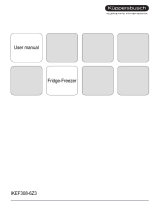
8
Butter and cheese com-
partment
Vegetable bins
Adjustable door rack
Adjustable shelves
Type plate
Cellar-temperature
compartment
Safety instructions and warnings
• To prevent injury or damage to the unit, the appliance should be
unpacked and set up by two people.
• In the event that the appliance is damaged on delivery, contact
the supplier immediately before connecting to the mains.
• To guarantee safe operation, ensure that the appliance is set up
and connected as described in these operating instructions.
• Disconnect the appliance from the mains if any fault occurs. Pull
out the plug, switch o or remove the fuse.
• When disconnecting the appliance, pull on the plug, not on the
cable.
• Any repairs and work on the appliance should only be carried
out by the customer service department, as unauthor ised work
could prove highly dangerous for the user. The same applies to
changing the mains power cable.
• Do not allow naked ames or ignition sources to enter the appli-
ance. When transporting and cleaning the appliance ensure that
the refrigerant circuit is not damaged. In the event of damage,
make sure that there are no ignition sources nearby and keep the
room well ventilated.
• Do not stand on the plinth, drawers or doors or use them to sup-
port anything else.
• This appliance is not intended for use by persons (including chil-
dren) with reduced physical, sensory or mental capabilities or lack
of experience and knowledge unless they have been given initial
supervision or instruction concerning use of the appliance by a
person responsible for their safety. Children should be supervised
to ensure that they do not play with the appliance.
• Avoid prolonged skin contact with cold surfaces or chilled/frozen
food. This could cause pain, numbness and frostbite. In the case
of prolonged skin contact, protective measures should be taken,
e.g. gloves should be worn.
• Do not eat ice cream, particulary ice lollies or ice cubes, imme-
diately after taking them from the freezer compartment as there
is a risk of "burning" because of the very cold temperatures.
• Do not consume food which has been stored for too long, as it
could cause food poisoning.
• The appliance is designed for cooling, freezing and storage of
food, and for making ice and is intended for domestic use. If used
for commercial purposes, the relevant legal regulations applicable
to the trade concerned must be observed.
• Do not store explosives or sprays using combustible propellants
such as butane, propane, pentane etc. in the appliance. Electrical
components might cause leaking gas to ignite. You may identify
such sprays by the printed contents or a ame symbol.
• Do not use electrical appliances inside the appliance.•
Do not connect the appliance to the supply with other equipment
using an extension cable. This can cause the extension socket to
overheat.
• Special-purpose lamps (incandescent lamps, LEDs, fluorescent
tubes) in the appliance serve to illuminate the appliance interior
and are not suited for room illumination.
Operating elements
Freezer compartment
Defrost drain
Description of appliance and equipment
Range of appliance use
The appliance is suited only for cooling food. In the case of com-
mercial food cooling, the pertinent statutory regulations have to
be observed.
The appliance is not suited for storing and cooling pharmaceuticals,
blood plasma, laboratory preparations or similar substances and
products subject to the Medical Devices Directive 2007/47/EC.
Any misuse of the appliance may result in damage to or spoilage
of the stored goods.
Furthermore, the appliance is unsuited for use in areas exposed
to an explosion hazard.
Disposal notes
• Keep packaging materials away from children - polythene
sheets and bags can cause suffocation!
• Please return the packaging to an official collection point.
Your old appliance: This contains some reusable materials
and should be disposed of properly - not simply with unsorted
household refuse.
• Discarded appliances should be disabled: Remove the
plug, cut through the connection cable and render the
catch unusable so that children cannot become trapped
inside.
• Ensure that the refrigerant circuit is not damaged when
the appliance that is no longer needed is taken away
for disposal.
• Details of the refrigerant can be found on the type plate.
• Appliances which are no longer needed must be disposed of in a
professional and appropriate way, in accordance with the current
local regulations and laws.
Remove all transit supports
Unscrew the red transport lock.
Close the vacated retaining hole using
the plug.







